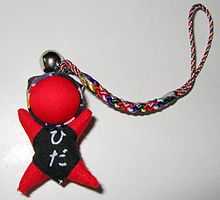Sarubobo

A sarubobo (さるぼぼ) is a Japanese amulet, particularly associated with the town of Takayama in Gifu Prefecture. Sarubobos are red human-shaped dolls, with no facial features, made in a variety of sizes. Traditionally, sarubobos are made by grandmothers for their grandchildren as dolls, and for their daughters as a charm for good marriage, good children and to ensure a well-rounded couple.
Etymology
Sarubobo literally translated from the Japanese as "a baby monkey". "Saru" is the Japanese word for monkey, and "bobo" is the word for baby in the dialect of Takayama.
There are several reasons why the amulet has this name. The sarubobo is associated with three wishes:
- Protection from bad things.
In Japanese, the English word "leave" translates as "saru", so possession of a sarubobo means that bad things will "saru"
- A happy home, a good match
In Japanese, a happy home is "kanai enman", a good match is "ryo-en" (Another way of saying "saru" is "en".)
- Having an easy delivery on birth.
Monkeys' childbirth is easy.
The face of the sarubobo is traditionally red, as is the face of baby monkeys.
Facelessness
Sarubobo dolls and charms usually have no facial features. The reasons for this are unclear, but some have been suggested. One suggestion is that, originally, sarubobos were made from left over cloth and made by relatives, so there was no need for them to be completely accurate.
Another suggestion is that the absence of a face allows the owner to imagine it - when the owner is sad, they can imagine their sarubobo to be sad too.
Modern sarubobo
Nowadays, sarubobo are a popular souvenir in Takayama, and are available in many different colours and shapes from souvenir shops. There is even a Hello Kitty doll dressed as a sarubobo.
The differently coloured sarubobos are each associated with different wishes;
- Blue sarubobo - for luck in study and work
- Pink sarubobo - for luck in love
- Green sarubobo - for luck in health
- Yellow sarubobo - for luck in money
- Black sarubobo - to remove bad luck
There is also a differently-shaped sarubobo called a "tobibobo."